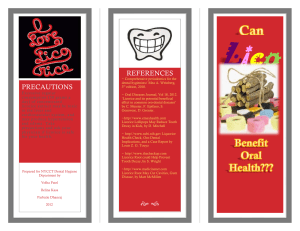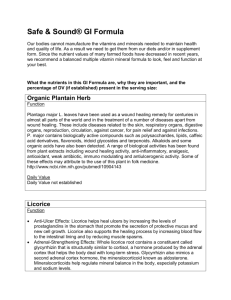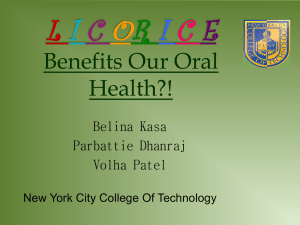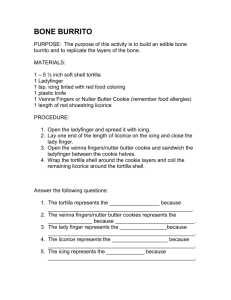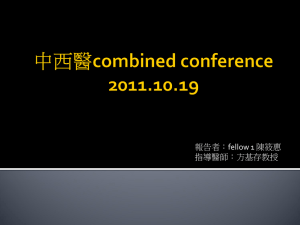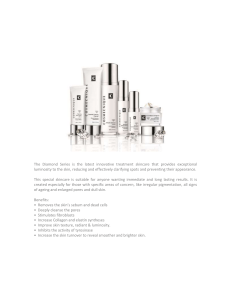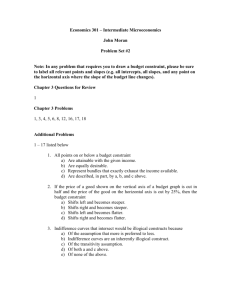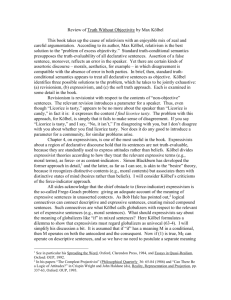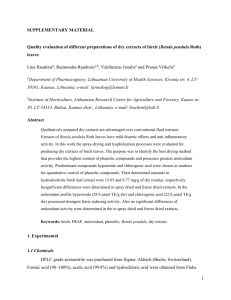Licorice - The Agricultural Research Center
advertisement
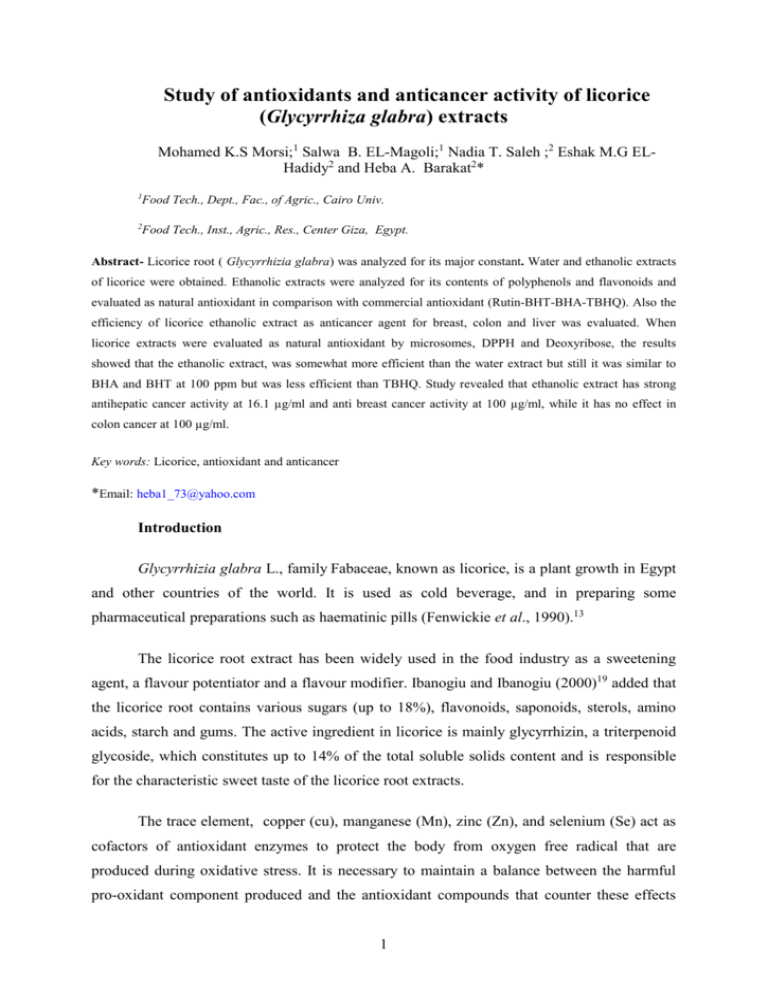
Study of antioxidants and anticancer activity of licorice (Glycyrrhiza glabra) extracts Mohamed K.S Morsi;1 Salwa B. EL-Magoli;1 Nadia T. Saleh ;2 Eshak M.G ELHadidy2 and Heba A. Barakat2* 1 Food Tech., Dept., Fac., of Agric., Cairo Univ. 2 Food Tech., Inst., Agric., Res., Center Giza, Egypt. Abstract- Licorice root ( Glycyrrhizia glabra) was analyzed for its major constant. Water and ethanolic extracts of licorice were obtained. Ethanolic extracts were analyzed for its contents of polyphenols and flavonoids and evaluated as natural antioxidant in comparison with commercial antioxidant (Rutin-BHT-BHA-TBHQ). Also the efficiency of licorice ethanolic extract as anticancer agent for breast, colon and liver was evaluated. When licorice extracts were evaluated as natural antioxidant by microsomes, DPPH and Deoxyribose, the results showed that the ethanolic extract, was somewhat more efficient than the water extract but still it was similar to BHA and BHT at 100 ppm but was less efficient than TBHQ. Study revealed that ethanolic extract has strong antihepatic cancer activity at 16.1 µg/ml and anti breast cancer activity at 100 µg/ml, while it has no effect in colon cancer at 100 µg/ml. Key words: Licorice, antioxidant and anticancer *Email: heba1_73@yahoo.com Introduction Glycyrrhizia glabra L., family Fabaceae, known as licorice, is a plant growth in Egypt and other countries of the world. It is used as cold beverage, and in preparing some pharmaceutical preparations such as haematinic pills (Fenwickie et al., 1990).13 The licorice root extract has been widely used in the food industry as a sweetening agent, a flavour potentiator and a flavour modifier. Ibanogiu and Ibanogiu (2000)19 added that the licorice root contains various sugars (up to 18%), flavonoids, saponoids, sterols, amino acids, starch and gums. The active ingredient in licorice is mainly glycyrrhizin, a triterpenoid glycoside, which constitutes up to 14% of the total soluble solids content and is responsible for the characteristic sweet taste of the licorice root extracts. The trace element, copper (cu), manganese (Mn), zinc (Zn), and selenium (Se) act as cofactors of antioxidant enzymes to protect the body from oxygen free radical that are produced during oxidative stress. It is necessary to maintain a balance between the harmful pro-oxidant component produced and the antioxidant compounds that counter these effects 1 (Leung, 1998).24 Antioxidant system depends first on the integrity of an enzymatic system that requires adequate intake of trace minerals such as selenium (Se), copper (Cu), manganese (Mn), and zinc (Zn) and second on adequate concentrations of vitamin E, C, A and β-carotene (Cirelli et al., 1991).6 Natural antioxidants include phenolic compounds (flavonoids, phenolic acids and tannins), nitrogen-containing compounds (alkaloids, chlorophyll derivatives, amino acids, peptides and amines), carotenoids, tocopherols and ascorbic acid or its derivatives. Crude extracts of species, herbs and other plant materials rich in polyphenolics are increasingly of interest to the food industry because they have the capacity to retard oxidative degradation of lipids and thereby improve the quality and nutritional value of food (Velioglu et al., 1998).35 Several research groups have investigated the chemical constituents and biological activities of licorice. Previous chemical studies have led to the identification of about 100 phenolic compounds, many of which are isoprenoid-substituted phenols. Most of these isoprenoid–substituted flavonoids are isoflavans with oxygen substituted at the C-5 position. Some of these flavonoids have shown inhibitory activities against bacterial growth (Fukai et al., 2004).14 Licorice flavonoids were found to have exceptionally strong antioxidant effects that were over 100 times stronger than that of vitamin E. A dose of 2.58 mg/ml licorice flavonoids was found to scavenge more free radicals than 258 mg/ml of vitamin E (20.6% vs 11.2%). Based on this report, flavonoids from licorice are currently the strongest natural antioxidants known (Ju, 1989).23 Amarowicz et al. (2004)2 found that the content of total phenolic compounds in the ethanolic extract of licorice root was 63 mg/g extract. Moreover, they investigated the antioxidant activity of licorice ethanolic extracts on their free radical scavenging capacity and their antioxidant activity by a number of chemical assays included a β- carotene-linoleic acid (linolate) model system, reducing power, scavenging effect on the DPPH, and free radical and capacity to scavenge hydroxyl free radicals (HO˙) by use of electron paramagnetic resonance (EPR) spectroscopy. They reported that the licorice extracts had powerful potential antioxidant activity. 2 Glabridin, a major flavonoid of Glycyrrhiza glabra (licorice), possesses multiple pharmacological activities, but it elevated the level of two endogenous antioxidants in the brain, i.e. superoxide dismutase (SOD) and reduced glutathione (GSH), Xue et al. (2008).38 There is a strong correlation between diet and cancer; the dietary constituents that inhibit mutagenesis and/or carcinogenesis are of paramount importance for the prevention of human cancer Gagandeep et al.( 2005).15 It has become increasingly obvious that chemicals found in our foods and beverages can prevent the genetic damage and hence leads to cancer initiation. Thus Shankel et al. (2000)31 described the antimutagenic potential of Glabrene (a compound isolate from Glycyrrhiza glabra). Duke et al. (2004)11 administration of licorice administrorice to hepatitis c patients prevented liver cancer and helped in treating stomach cancer. They added that alpha terpinol, anethole, apigenin, benzaldehyde, bergapten, camphor, estragole, eugenol, ferulic acid, formanonetin, galangin, genistein, geraniol, glabrene, glabridin, glabrol, glycrrhetic acid, glycrrhetinic acid, glycyrrhizic acid, glycyrrhizin, indole, isoliquirtigenin, isoquercitrin, kaempferol, licoumarone, licoflavanone, lignin, linalool, liquiritigenin maltol, methyl salicylate, naringenin, o-cresol, ρ–hydroxylbenzoic acid, ρ– methyl- phenol, phenol, quercetin, salicylic acid, sinapic acid, soyasaponin, umbelliferone, vitexin and xanthotoxin had anticancer effect. The ethanol extract of Chinese licorice root, Glycyrrhiza uralensis (G. uralensis) was investigated for its estrogenic effect and its ability to inhibit cell proliferation in the MCF-7 human breast cancer cell line. This study showed that the ethanolic extract of the root of G. uralensis has an estrogen-like activity and anti-cancer effects against MCF-7 human breast cancer cells. On the other hand the use of phytoestrogens to protect against hormone-dependent cancers or its use as a ‘natural’ alternative to hormone replacement therapy remains controversial Jo et al. (2005).21 Isoliquiritigenin acts as a monofunctional inducer of phase II enzymes through the activation of the anti oxidant response element (ARE) Cuendet et al (2006).8 This compound exhibited cytotoxic activity against several cancer cell lines Maggiolini et al (2002)26 and Takahashi et al (2006).34 Licorice was selected for study because of its peroxynitrite scavenging activity (88.3% scavenging activity at 20 µg/mL). Biological studies have demonstrated that thechemical constituents of licorice have a variety of biological effects, such as antiinflammatory, anti-ulcer, antihepatotoxic, antimicrobial, antioxidant, cytoprotective, and cytotoxic activities. All isolates compounds such as, hispaglabridin B, isoliquiritigenin, and paratocarpin B were found to be the most potent anti-oxidant agents. Furthermore, isoliquiritigenin was demonstrated to prevent the incidence of 1,2-dimethylhydrazine-induced 3 colon and lung tumors in mice when administered at a dose of 300 mg/kg. Chin, et al (2007)7 and Takahashi et al (2006).34 For these reasons this study was carried out to determine efficiency of ethanolic and water extract of licorice as antioxidant and anticancer agents for breast, liver and colon. Material and Methods Material Licorice powder root was obtained from the local market. Samples were ground. Fifty gm sample were soaked in either 500 ml water (to obtaine water extract) or 500 ml 95% ethanol (to obtaine ethanol extract) for 48 hr at room temperature with occasional shaking. Mixter was filtered through cheese cloth followed by filter paper. Ethanolic solution was evaporated in water bath at 40 оC till completely evaporation of ethanol and yield was in the form of thick paste.Water extract solution was freeze dried at (-30 оC) under high vacuum, the yield was highly hydroscopic powder. Methods 1-The chemical analysis included, moisture, ash, ether extract, crude fiber and crude protein were determined according the procedures described in AOAC (1995).4 While, nitrogen free extract % was calculated by difference [100-(ash+protein+ether extract+crud fiber)]. 2- Chemical contents of the most effective antioxidant components in licorice root wre measured. a- Phenols were determined colorimetrically as described by Daniel and George (1957). 9 b- Flavonoids were determined according to the methods of Snell and Snell (1954).33 c- Carotenoids were determined according to the methods of Fedtke (1973).12 d- Total tannins and ascorbic acid were determined colorimetry as described by AOAC (1995).4 e- Saponins were determined by the method of Hiai et al. (1976).16 3- K, Na, Ca, Fe, Mn, Zn, Cu and Mg in licorice root and its water and ethanol extracts were determined using Atomic Absorption Spectrometry (AAS) (model pye-Unicom sp-3300), according to the method illustrated by Kirlies (1984).24 4 4- Polyphenols and flavonoids Contents in the ethanolic extract of liquorice were determined using HPLC (Hewlett Packard series 1100). Column used was hypersil BDS 5 µm C 18, detector was uv 254 nm, solvent used were A: (0.50 ml acetic acid/99.50 ml distilled water), B: (0.50 ml acetic acid/99.50 ml acetonitrile) flow rate 1 ml/min in a gradient system starting with 100% A and ending with 100% B through 35 min at temperature ambient 25 оC according to Merfort et al. (1997).28 5- Effect of ethanol and water extracts as antioxidant. a- Microsomes from rat liver were used for lipid peroxidation test according to the methods of Josephson and Gyllensward. (1957) 22 and Buega and Aust (1978).5 b- The free radical scavenging effect of the licorice extract was assessed by the decolouration of a methanolic solution of 1,1-diphenyl-2-picrylhydrazyl (DPPH) radical (violet colour) according to the method of Viturro et al. (1999).36 C- Hydroxyl radical scavenging activity effect of the licorice extracts was measured according to the method of Panovska et al (2005).29 d- The designation of induction period by rancimat instrument was taken as a tool to compare the effectiveness of licorice extract fractions on corn oil stability against corn oil antioxidant according to the method of Mendz et al. (1997).27 6- Effect of ethanol extract as anticancer. Measurement of potential cytotoxicity activity of ethanol extract of licorice against the liver carcinoma cell line (HEPG2), colon carcinoma cell line (HCT116) and breast carcinoma cell line (MCF7) was tested by SRB assay using the method of Skehane et al. (1990).32 This experiment was conducted in Egyptian Cancer Institute, Cairo, Egypt. Results and Discussions 1-Chemical analysis of licorice Results in Table (1) showed that the licorice root contains 7.97% protein, while it was rich in N.F.E and crud fiber (47.58 and 37.68%, respectively). These data are in agreement with Duka (1985).10 5 Table (1): Chemical composition of licorice (% on dry weight basis) Components % Ash 5.42 Crude protein 7.97 Ether extract 1.35 Crud fiber 37.6 % Nitrogen free extract (N.F.E) 47.66 (by difference) Moisture 9.04 % Nitrogen free extract=100-(ash+protein+ether extract+crud fiber). The results in Table (2) showed that raw, ethanol or water extract of licorice contained some micro-elements such as Cu, Zn, Mn and Mg. The ethanol extract contains more Zn and Cu than the water extract, while water extract contains more Na than ethanol extract, but both contain nearly the same content of Mg. On the other hand Al-Bachir (2004)1 reported that licorice root solution contained 5 mg/g calcium, 23.2 mg/g potassium and 17.2 mg/g sodium. Ansari et al. (2004)3 noticed that Glycyrrhiza glabra contained more than50 µg/g copper whereas it was very rich in Fe contents >4000 µg/g. Finally the difference between the results of the present study and the results of the other investigators may be due to one or more of the following reasons: type, varieties, geographical origins, environmental condition or the method applied in the extraction-transportation and storage of the root. Results in Table (3) showed that licorice contains reasonable amounts of total phenols, flavonoids, saponins (405.02, 114.91 and 27.99 mg/100 g, respectively). It also contains moderate amounts of tannins and carotenoids (47.54, 11.78 mg/100g, respectively). These data are in close agreement with results represent in Sharma (2004)30 who reported that licorice contains about 5-20% saponins. 6 Table (2): Minerals content of raw and ethanol extract on licorice root (mg/100g on dry weight basis) Minerals Licorice (raw) root Ethanol extract Water extract (DWB) (DWB) (DWB) Mg 473.51 175.9 174.7 Na 180.48 66.63 122.8 Zn 1.312 0.511 0.40 Mn 1.25 0.151 0.40 Fe 25.27 5.97 1.19 Ca 984.01 528.61 104.55 K 480.17 349.54 341.5 Cu 0.843 0.310 0.18 Table (3): Antioxidants content of licorice root (mg/100g on dry weight basis) Components mg/100g (DWB) Total phenol 405.02 Total flavonoids 114.91 Tannins 47.54 Saponins 27.99 Carotenoids 11.78 Vitamin C 1.20 2- Polyphenols and flavonoids in licorice ethanol extract An extract of licorice roots has been reported recently to possess scavenging effects against peroxynitrite as well as nitric oxide, but the active principles were not individually established. The phenolic compounds isolated and investigated may be responsible, at least in part, for such peroxynitrite scavenging activity (Yokozawa et al., 2005).37 Results in Table (4) showed that polyphenol and flavonoids of Licorice contained high contents of kaempherol and cinnamic acid (32.95 and 31.22 µg/g, respectively) then apignin and Myrcetin (29.97 and 27.62 µg/g, respectively). In contrast, its content of resrocenol and protocatechuic acid were lower than other components (9.22 and11.50 µg/g, respectively). On the other hand salicylic acid and quercetin were not detected. (Hirano et al., 2001)17demnstrated that the components structure of Rutin, cinnamic acid , Quercetin, and Kaempherol were the best scavenging of free radicals. 7 Table (4): Polyphenols and flavonoids in licorice ethanol extract (µg/g dry weight basis) of the root Compounds Resrocenol Protocatechuic acid OH-benzoic acid Phenol Vanillin p-coumaric Ferulic acid Salicylic acid Rutin Myrcetin Apignin Cinnamic acid Quercetin Kaempherol Rt= Retention time Rt 9.565 11.142 14.420 18.399 19.156 21.025 22.465 22.972 24.006 28.030 29.368 31.213 32.213 36.286 µg/g(root)DWB 9.22 11.50 14.40 18.40 20.43 21.67 22.54 24.41 27.62 29.97 31.22 32.95 3-Free radical scavenging activity of licorice extract by different methods The free radicals scavenging activity of licorice ethanol and water extracts were assessed by the DPPH test. The activity of licorice extract was individually tested in triplicates using different concentrations (50, 100 and 200 µg/ml) respectively compared with rutin (as natural antioxidant) and BHT (as synthetic antioxidant). Data in Table (5) showed that the activity of the extract increases by increasing the concentration. The ethanol extract was more effective than the water extract, 24.5-42.4-82.1% and 12.0-17.7-28.1% for 50, 100 and 200 µg/ml respectively). On the other hand, ethanol extract activity was somewhat higher than BHT (82.1 and 78.8, respectively) at 200 µg/ml. Table (5): Effect of licorice (ethanol or water) extract on free radical scavenging activity (DPPH) Samples 50 µg/ml 100 µg/ml 200 µg/ml Rutin 97.0 97.0 97.5 BHT 27.4 60.2 78.8 Ethanol extract 24.5 42.4 82.1 Water extract 12.0 17.7 28.1 Data in Table (6) showed that the inhibitory effects of successive extracts of licorice by the three concentrations against lipid peroxidation of microsomes were increased gradually with increasing the concentration. Moreover, the highest inhibition value of licorice ethanolic 8 extracts (1 mg/ml) was 79.9%, while water extract of licorice had the lowest value (22.3%) compared with Rutin and BHT (96.5 and 94.8%, respectively) in the same concentration. Table (6): Effect of licorice (ethanol or water) extract on lipid peroxidation in rat liver microsomes Samples % Inhibition 0.25 mg/ml 0.5 mg/ml 1.0 mg/ml Rutin 91.2 94.0 96.5 BHT 71.3 88.5 94.8 Ethanol extract 25.5 43.6 79.9 Water extract 7.6 14.2 22.3 From the data in Table (7) it is observed that the inhibition value of licorice against deoxyribose was increased by increasing the concentration. The highest activity of deoxyribose present in Rutin, BHT and licorice ethanol extract were 73.6-67.8 and 53.9% respectively at (1 mg/ml), while the activity of water extract of licorice was 19.5% in the same concentration. Table (7): Effect of licorice (ethanol or water) extract on hydroxyl radical scavenging activity (Deoxyribose) Samples Rutin BHT Ethanol extract Water extract % Inhibition 0.5 mg/ml 70.4 52.5 34.2 16.5 0.25 mg/ml 67.4 39.1 21.1 12.0 1.0 mg/ml 73.6 67.8 53.9 19.5 Results in Table (8) showed the effect of licorice (ethanol or water) extract on oxidative rancidity of corn oil .Corn oil without any added antioxidant (control) and corn oil mixed with (TBHQ, BHA and BHT) at concentration 100 and 200 ppm, were used as a guide to indicate the antioxidant activity against different concentration of licorice ethanol or water extracts. The percentage antioxidant activity (AA) was calculated from the equation: AA% = Induction period of sample-Induction period of control x 100 Induction period of control From data in Table (8) one can observe that the induction period of control was 9.2 (hr) while, by increasing the concentration of licorice (ethanol) extracts to 280, 440, 800 and 1000 ppm or increasing concentration of water extracts 1000, 3000, 5000 and 7000 ppm respectively led to a gradual increase in the antioxidant activity which were 50, 54.34, 56.52 9 and 59.7 or 47.8, 55.43, 57.6 and 59.7 respectively. On the other hand antioxidant activities of corn oil with synthetic antioxidant as TBHQ, BHA and BHT at 100, 200 ppm were 215.2, 44.5 and 47.8 at 100 ppm and 298.9, 63.04 and 68.47 at 200 ppm respectively. Ethanolic extract Water extract Table (8): Effect of Licorice extracts (ethanol & water) on corn oil (Oxidative rancidity) System Induction period (h) Control (corn oil) 9.2 Percentage antioxidant activity - C +TBHQ (100 ppm) 29 215.21 C + TBHQ (200 ppm) 36.7 298.91 C + BHA (100 ppm) 13.3 44.56 C + BHA (200 ppm) 15 63.04 C + BHT (100 ppm) 13.6 47.82 C + BHT (200 ppm) 15.5 68.47 C + Licorice (1000 ppm) 13.6 47.82 C + Licorice (3000 ppm) 14.3 55.43 C + Licorice (5000 ppm) 14.5 57.60 C + Licorice (7000 ppm) 14.7 59.78 C + Licorice (280 ppm) 13.8 50 C + Licorice (440 ppm) 14.2 54.34 C + Licorice (800 ppm) 14.4 56.52 C + Licorice (1000 ppmM,) 14.7 59.78 AA% = Induction period of sample-Induction period of control x 100 Induction period of control Conclusively, the ethanol extract was more effective than the water extract as natural antioxidant, and its efficiency increased gradually by increasing its concentration in all method used. These results proved that polyphenols and flavonoids in licorice extracts are powerful antioxidant. These data confirm results by Amarowicz et al. (2004)2 who found that the ethanol extract of licorice is useful as scavenging agent as measured by DPPH method. 4-Efficency of licorice extracts as anticancer agent. Results in Table (9) showed that cytotoxic activity of licorice ethanol extract as anticancer agent for different organism. 10 Table (9): cytotoxic activity of the licorice extract Concentration µg/ml 0.0 10.0 25.0 50.0 100.0 IC 50 (µg) HEPG2 (liver) 1.000 0.553 0.448 0.431 0.271 16.1 HCT 116 (colon) MCF 7 (breast) 1.000 0.697 0.594 0.588 0.556 - 1.000 0.657 0.610 0.546 0.50.9 100 HEPG 2 (Liver carcinoma cell line) HCT 116 (colon carcinoma cell line) MCF7 (Breast carcinoma cell line) IC 50(dose of the tested compound which reduces survival to50%) Data in Table (9) showed that the most efficient cytotoxic activity of the licorice ethanol extract was against (liver cancer) HEPG 2 (IC50=16.1), then against (breast cancer) MCF 7 (IC50=100) while it has no efficiency cytotoxic activity against (colon cancer) HCT. These data confirmed past results reported by Jo et al., (2004)20 and Hulka and Moorman (2001),18 who found that the cytotoxic activity of the licorice was against breast cancer. 11 References 1. Al Bachir, M.; Al Adawi, M. A. and Al Kaid, A. (2004). Effect of gamma irradiation on microbiological, chemical and sensory characteristics of licorice root product. Radiation Pysics Chem., 69: 333-338. 2. Amarowicz, R.; Pegg, R.B.; Rahimi, P.; Barl, B. and Weil, J.A. (2004). Free–radical scavenging capacity and antioxidant activity of selected plant species from the Canadian prairies. Food Chem., 84: 551-562. 3. Ansari, T. M.; Ikram, N.; Najam, M. H.; Fayyaz, I.; Fayyaze, O.; Ghafoor, I. and Khalid, N. (2004). Essential trace metal (zinc, manganese, copper and iron) levels in plants of medicinal importance, J. Bio. Sci., 4(2): 95-99. 4. A.O.A.C. (1995). Official Methods of Analysis of the Association of Official Analytical Chemists. 16th Ed., Published by the Association of Official Analytical Chemists. Arlington, Virginia, 2220 USA. 5. Buege J.A, Aust SD, 1978. Mirosomal lipid peroxidation. In Methods in Enzymology, Vol. 52, Fleische S, Packer L (eds). Academic Press: New York; 302-310. 6. Cirelli, A.; Ciardi, M. and Simone, C. (1991) Serum selenium concentration and disease progress in patients with HIV-infection.Clin. Biochem., 24, 211-214. 7. Chin,Y-W.; Jung, H-A.; Liu,Y.; Su, B-N.; Castoro, J.A.; Keller, W. J. ; Pereira, M.A. and Kinghorn, D (2007). Anti-oxidant Constituents of the Roots and Stolons of Licorice (Glycyrrhiza glabra) J. Agric. Food Chem 55, 4691-4697. 12 8. Cuendet, M.; Otehan, C. P.; Moon, R. C. and Pezzuto, J. M. (2006). Quinone reductase induction as a biomarker for cancer chemoprevention. J. Nat. Prod. 69, 460-463. 9. Daniel, H.D. and George, C.M. (1957). Peach seed dormancy in relation to endogenous inhibitors and applied growth substances. J. Am. Soc. Horti. Sci., 97 : 651-654. 10. Duke, J. A (1985). Hand book of medicinal herbs. CRC, Boca Raton. p.p 90. 11. Duke, J. A.; Godwin, M. B.; Cellier, J. and Duke, P. A. (2004). CRC Hand Book of Medicinal Spices. CRC Hand Book, Boca Raton, London, New York, Washington. p.p 174-181. 12. Fedtke, C. (1973). Effect of the herbicide methanbenzthiazoron on the physiology of wheat plants. Pesticide Sci., 4, 653-664. 13. Fenwickie, G.; Lutomski, J. and Nieman, C. (1990). Liquorice, Glycrrhiza glabra L. composition, uses and analysis. Food Chem., 38(2): 119-143. 14. Fukai, T., Oku, Y., Hano, Y. and Terada, S. (2004). Antimicrobial activities of hydrophobic 2-arylbenzofurans and an isoflavone against vancomycin-resistant enterococci and methicillin-resistant Staphylococcus aureus. Planta Med., 70: 685-687. 15. Gagandeep, A.; Dhiman, M.; Mendiz, E.; Rao, A. R. and Rale, R. K. (2005). Chemopreventive effects of mustard (Brassica Compestris) on chemically induced tumorigenesis in murine forestomach and uterine cervix. Human Experimental Toxicol., 24 (6): 303-312. 16. Hiai, S.; Qura, H. and Nakajima, T. (1976). Color reaction of some sapogenins and saponin with vanillin and sulfuric acid, Planta Medica, 29, 116-122. 17. Hirano, R.; Sasamoto, W.; Itakura, A.; Igarachi, O. and Kondo, K. (2001). Antioxidant ability of various flavonoids against DPPH radicals and LDL oxidation. J. Nutr. Sci. and Vitaminol., 47: 357-362. 18. Hulka, B.S and Moorman, P.G (2001). Breast cancer: hormones and other risk factors, Maturitas 38, 103-113. 19. Ibanogiu, E. and Ibanogiu, S. (2000). Foaming behaviour of liquorice Glycyrrhiza glabra extract. Food Chem., 70: 333-336. 20. Jo, E-H.; Hee, D-H.; Mam, C-A.; Ji, W-J.; See, R-Y.; Joonsuk, P.; Sung, H-k.; lee, Y-S. and Kyung, S-K. (2004). Modulations of the BCI-2Bax family were involved in the chemopreventive effects of licorice root (Glycyrrhizia uralensis fisch) in MCF-7 breast 13 cancer H. Agric. Food Chem., 52(6): 1715-1719. 21. Jo, E.-H.; Kim, S.-H.; Ra, J.-C.; Kim, S.-R.; Cho, S.-D.; Jung, J.-W.; Yang, S.-R.; Park, J.-S.; Hwang, J.-W.; Aruoma, O. I.; Kim, T.-Y.; Lee, Y.-S.; Kang, K.-S. (2005). Chemopreventive properties of the ethanol extract of chinese licorice (Glycyrrhiza uralensis) root: induction of apoptosis and G1 cell cycle arrest in MCF-7 human breast cancer cells. Cancer Letters, 230: 239–247. 22. Josephson, B and Gyllensward, C. (1957). The development of the protein fractions and of cholesterol concentration in the serum of normal infants and children. Scand. J. Clin. Lab. Invest., 9 (1): 29-38. 23. Ju, H.S. (1989). Effects of Glycyrrhiza Flavonoids on lipid peroxidation and active oxygen radicals. Acta Pharmaceutica Sinicia, 24 (11): 807-812. 24. Kirleis , A. W.; Sommers, L. E. and Nelson, D. W. (1984). Yield heavy metal content and milling and biking properties of soft red witer wheat grown no soils amended with sewage sludge. Cereal Chem., 61 (6):581-522. 25. Leung, F.A. (1998). Trace elements that act as antioxidant in parenteral micronutrition. J.Nutr. Biochem., 9: 304-307. 26. Maggiolini, M.; Statti, G.; Vivasqua, A.; Gabriele, S.; Rago, V.; Loizzo, M.; Menichini, F. and Amdo, S. (2002). Estrogenic and antiproliferative activities of isoliquiritigenin in MCF-7 breast cancer cells. J. Steroid Biochem. Mol. Biol. 82, 315-322. 27. Mendz, E.; Sanhaeza, J.; Speisky, H. and Valenzuela, A. (1997). Comparison of rancimat evaluation modes to assess oxidative stability of fish oils. J. A. O. C. S., 74 (3): 331-332. 28. Merfort, I.; Wray, V.; Barakat, H.H.; Hussen, S.A.M.; Nawwar, M.A.M. and Willuhan, G. (1997). Flavonol triglycerides from seeds of Nigella sativa.Phytochem., 46 (2):359-363. 29. Panovska, T. K.;Kulevanova , Sand Stefova, M. (2005). Invitro antioxidant activity of some teucrium species (Lamiaceae) Acta pharm., 55: 207-214. 30. Sharma, R. (2004). Agro-Techniques of medical plants. (Green Foundation for Healthcare, Socialequity and Biodiversity Conservation) Dehradun (utaran chal) Daya Publishining House. Delhi-110035. 31. Shankel, D. M.; Pillai, S. P.; Telikepalli, H.; Menon, S. R.; Pillai, C. A. and Mitscher, L. A. (2000). Role of antimutagens/anticarcinogens in cancer prevention. Bio. Facts, 12 (1/4): 113-121. 32. Skehane, P.; Storeng, R.; Scudiero, D; Monks, A.; McMahon, J.; Vistica, D.; Warren, J.T.; Bokesch, H.; Kenney, S. and Boyd, M.R. (1990). New colorimetric 14 cytotoxicity assay for anticancer-drug screening. J. Natl. Cancer Inst., 82: 1107-1112. 33. Snell, F. and Snell, C. (1954). Colorimetric method of analysis, 3 rd ed. D. Von Nostrand and Co., New York. 34.Takahashi, T.; Baba, M.; Nishino, H.and Okuyama, T. (2006). Cyclooxygenase- 2 plays a suppressive role for induction of apoptosis in isoliquiritigenin-treated mouse colon cancer cells. Cancer Lett. 231, 319-325. 35. Velioglu, y. S.; Mazza, G.; Gao, L. and Oomah, B. D. (1998). Antioxidant activity and total phenolics in selected fruits, vegetables, and grain products. J. Agric. Food Chem., 46: 4113-4117. 36. Viturro, c.; Molina, A. and Schmeda-Hirchmann, G. (1999). Free radical scavengers from Mutisia friesiana (Asteraceae) and sanicula graveolens (Apiaceae). phytother. Res.13: 422-424. 37. Yokozawa, T.; Cho, E. J.; Rhyu, D. Y.; Shibahara, N.and Aoyagi, K. (2005). Glycyrrhizae radix attenuates peroxynitrite-induced renal oxidative damage through inhibition of protein nitration. Free Radical Res. 39, 203-211. 38. Xue, Q. Y.; Xue, C.C.; Zhou, Z.W.; Li, C,G.; Du, Y. M.; Zhou, F.Z. (2008). In vitro and in vivo neuroprotective effect and mechanisms of glabridin, a major active isoflavan from Glycyrrhizae glabra (licorice). Life Sciences, Volume 82, Issues 1-2, 68-78. دراسة نشاط مستخالصات العرقسوس كمضادات لالكسدة واالورام ا.د .محمد خيرى , 1ا.د سلوى المجولى, 1د .نادية صالح , 2د .اسحاق الحديدى , 2هبة بركات 2 1قسم الصناعات الغذائية – كلية الزراعة – جامعة القاهرة 2معهد بحوث تكنولوجيا األغذية –مركز البحوث الزراعية الملخص العربى تممم تقممدير البركيممم الكينممائا لنبممات العرقسمموو بعاىممم الحصممو علمما النسممبئل محبوى النسبئل النسبئل اويقمماىولا يالنممائا لم ي قممد تممم ت ريممد اويقاىولا من ال ينووت يال الفوىيدات يكذلك تقين كنضما اكسمدة يبيعما بعاىمم راتمة تمااير ك ما اويقاىولا كنضا لالير ام مقل تريان القدى ي القولون يالكبد .يايضحت النبائج عند تقميم العرقسموو كنضما اكسدة يبيعا ان قدر النسبئل اويقاىولا كنضا اكسد ت وق قدر النسبئل تااير لكال من الريوتين – .BHTبيننا عند تقيم النسبئل فمما تممااير كنضمما اكسممدة مممن النسممبئل النائا بحوالا االا اضمعا بطريق الراىسينات يجمد ان النسمبئل النممائا .كنمما يجممد ان السممبئل يمناامل فما اويقماىولا كمان علما اويقمماىولا مبقممار فمما تمم ايرة لكممل مممن BHAي .BHTعند تركيز 100 ppmيلكنة اقمل ممن .TBHQكنما ايضمحت الدراتم ان للنسمبئل اويقماىولا تمااير قوى علا تريان الكبد يالقدى حيث كان تمااير الننيمت لنصمد عمد الئاليما النسمرين همو 11,1ي111ميكريجمرام ججمم علا البوالا بيننا لم يحدث اى تااير علا تريان القولون. 15
